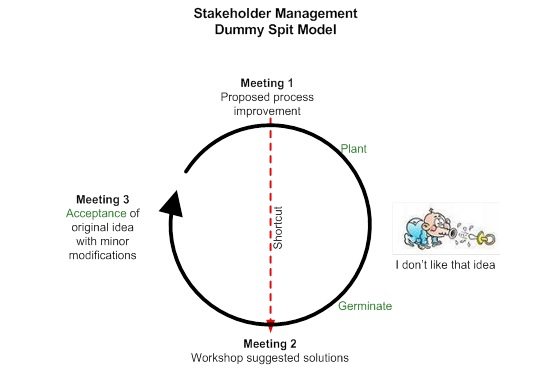Background
James Cattermole and Josh Keegan have had over 30 years combined experience working for a number of differing organisations through process improvement and change management. Over the years, as separate individuals both have had similar successes (and failures) engaging stakeholders when proposing a new idea or solution to an existing problem. Both James and Josh worked together for a large local government organisation and it was during this time that the following model was formulated.
Josh: “I was discussing the results of one of my workshops with James where a new ‘To-Be’ process model was being proposed and summarily pulled apart out of frustration that the idea wasn’t being accepted. During this discussion that James came up with the “Dummy Spit” model to accurately reflect what each stakeholder was going through.
The model has been built to diffuse a frustrating situation and is based upon empirical evidence gained from numerous meetings/workshops that we have either facilitated or attended.”
The model explained
Meeting/Workshop 1 – During the first workshop, the process improvement is proposed amongst key stakeholders, process owners and senior managers. Empirical evidence suggests, that through individual meetings with people key to the proposed process improvement, generally agree that the end result you are trying to achieve possible and there is nothing standing in your way.
The same can not be said for when they are all gathered in the same room under the banner of ‘workshop’ where the proposed solution is presented with all potential savings. Empirical evidence in this instance seems to suggest that participants are more willing to pull apart the solution once they are amongst their peers. This is generally in spite of evidence gathered prior suggesting that the solution will not only work in the existing systems without any major changes, but also includes any cost-benefit analysis that you have completed demonstrating the overall savings that can be directly attributed to the proposal. It would seem that once everyone is gathered in the same room everyone will have the “Dummy Spit” leaving the workshop facilitators with an overall feeling that the new process is lost.
It is important to note at this point, that whilst there is a strong sense of objection to the new proposed process, there are still supporters within the group. These people generally agree with you and don’t understand the objections others raised. It is a wise facilitator that uses these comments to fortify your resolve for change and work towards meeting/workshop 2.
Meeting/Workshop 2 – At the time the new process is being dismantled or shot down, the idea has been successfully implanted the minds of all the workshop participants. Empirical evidence suggests that between the first meeting/workshop and the second meeting/workshop the new process has had time to germinate in the minds of the participants. When the second workshop is run and participants are asked to come up with suggested solutions to help resolve the issue highlighted in the first workshop through a brain storming activity. Within the suggested solutions, participants come up with a modified solution that was presented to them in the first workshop. It is in the best interests of the presenters, at this stage, to only collate all ideas ready for the next workshop.
The idea or solution that has been presented in the first workshop is germinating and is taking root in the minds of those who originally opposed it.
Meeting/Workshop 3 – It is during the third and final workshop that all participants accept the idea that was originally suggested in the first workshop, albeit with minor modifications.
The key essential element of this model is to allow any group of participants to have a “Dummy Spit”, vocalise their concerns and raise objections to any new process in the first workshop. It is essential to note that as a workshop facilitator that you are unable to go from introducing the idea in meeting/workshop 1 to acceptance of the idea in meeting/workshop 2. Attempting to take the “shortcut” and expecting an acceptance of the idea immediately only leads to frustration of the facilitator and the workshop participants. Why? Essentially, the participants need to have the seed planted and get used to a new idea. It needs time to germinate in the minds of participants allowing them to mull it over weighing up the pros and cons before finally putting a level of support behind it.
A WORD OF CAUTION: Having conducted a number of workshops, both the authors have noted that there is always a participant that is pushing their own agenda regarding something that they would like to attach to your project. It is worthwhile listening to what they are attempting to attach to your project and quickly make a decision if it is “in” or “out” of the scope of your project. Making this decision early in the workshop prevents scope creep and the workshop and project from being derailed. It also leads to another model the authors have found in workshops called “Pushing their own wheelbarrow”, but we will explore that one another time.

